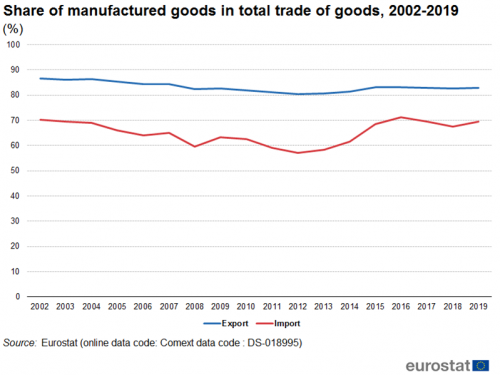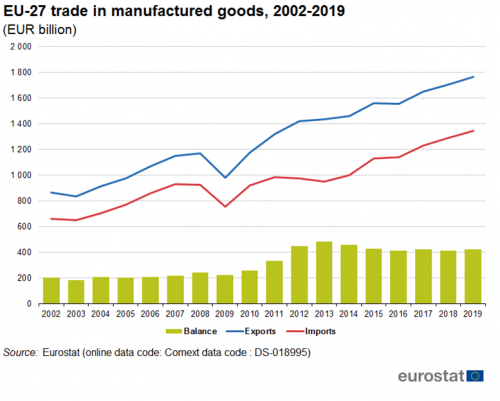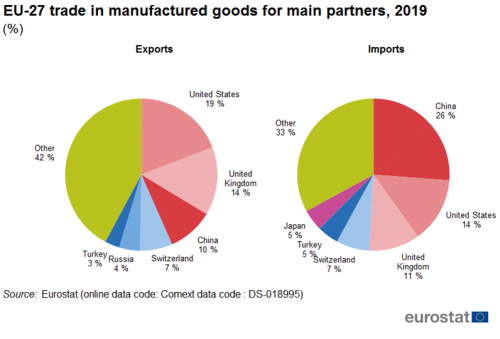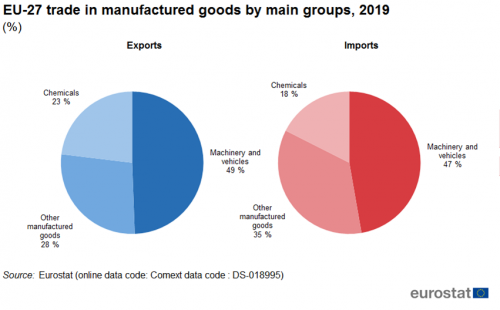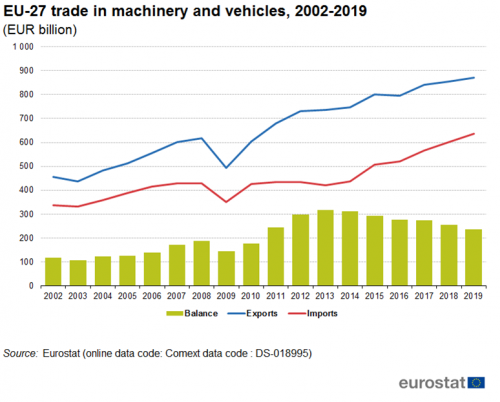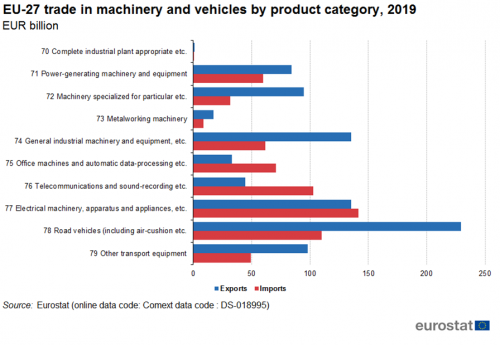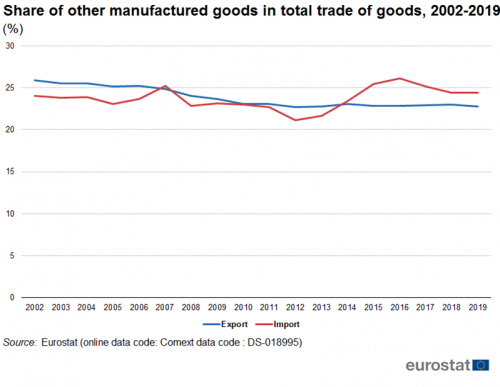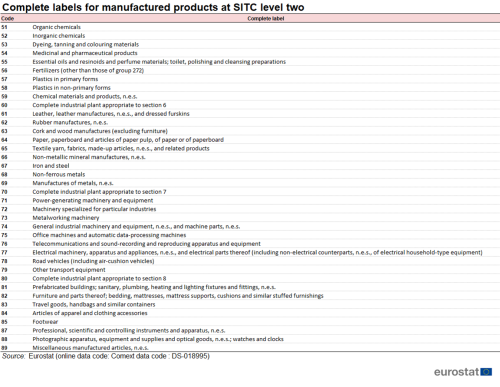Archive:Extra-EU trade in manufactured goods
Data from April 2020
Planned update: April 2021
Highlights
In 2019, manufactured goods made up 83 % of all EU exports and 70 % of EU imports.
The United States, United Kingdom and China were the main EU trading partners for manufactured goods in 2019.
EU-28 exports, imports and trade balance in manufactured products, 2002-2018
This article focuses on the structure and evolution of the European Union (EU) international trade in manufactured goods: imports and exports at EU level.
This article is part of an online publication providing recent statistics on international trade in goods, covering information on the EU's main partners, main products traded, specific characteristics of trade as well as background information.
Full article
The Standard international trade classification (SITC) distinguishes four main groups (sections) of manufactured goods:
- chemicals (SITC 5);
- manufactured goods classified chiefly by material (SITC 6);
- machinery and vehicles (SITC 7);
- miscellaneous manufactured articles (SITC 8).
Categories 6 and 8 are often grouped together as 'other manufactured goods'. This grouping is also used in this article.
Manufactured goods dominate international trade
The share of manufactured goods in total exports of goods decreased from 86.6 % in 2002 to 82.8 % in 2019 (Figure 1). It peaked in 2002 at 86.6 % and had its lowest value in 2012 at 80.3 %. The share of manufactured goods in total imports of goods decreased from 70.3 % in 2002 to 69.5 % in 2019. It peaked in 2016 at 71.3 % and had its lowest value in 2012 at 57.2 %.
Between 2002 and 2019,exports of manufactured goods increased by EUR 900 billion, from EUR 865 billion to EUR 1 765 billion (Figure 2). This was equivalent to an average annual growth rate of 4.3 %. In this period, imports of manufactured goods increased by EUR 682 billion, from EUR 662 billion to EUR 1 344 billion. This was equivalent to an average annual growth rate of 4.3 %. In this period, the trade balance increased from EUR 204 billion to EUR 421 billion. It had its lowest value of EUR 182 billion in 2003 and peaked in 2012 at EUR 483 billion.
The United States was the largest export partner for manufactured goods in 2019 with a share of 19 %. The top six partners accounted for 58 % of total exports of manufactured goods. China was the largest import partner for manufactured goods in 2019 with a share of 26 %. The top six partners accounted for 67 % of total imports of manufactured goods.
Within manufactured products, machinery and vehicles was the largest group, both in exports (41 %) and imports (33 %). In both cases other manufactured goods was the second largest group (23 % in exports and 24 % in imports) followed by chemicals (19 % in exports and 12 % in imports).
In the next three paragraphs these three groups.
Machinery and vehicles largest sector in manufactured goods
The share of machinery and vehicles in total exports of goods decreased from 45.6 % in 2002 to 40.9 % in 2019 (Figure 5). It peaked in 2002 at 45.6 % and had its lowest value in 2019 at 40.9 %. The share of machinery and vehicles in total imports of goods decreased from 36.0 % in 2002 to 32.8 % in 2019. It peaked in 2002 at 36.0 % and had its lowest value in 2012 at 25.6 %.
Between 2002 and 2019,exports of machinery and vehicles increased by EUR 417 billion, from EUR 455 billion to EUR 872 billion (Figure 6). This was equivalent to an average annual growth rate of 3.9 %. In this period, imports of machinery and vehicles increased by EUR 297 billion, from EUR 338 billion to EUR 635 billion. This was equivalent to an average annual growth rate of 3.8 %. In this period, the trade balance increased from EUR 117 billion to EUR 237 billion. It had its lowest value of EUR 106 billion in 2003 and peaked in 2012 at EUR 317 billion.
The largest category in exports of machinery and vehicles was road vehicles (26 %). It was followed by general industrial machinery and equipment (16 %) and electrical machinery and parts thereof (16 %).
The United States was the largest export partner for machinery and vehicles in 2019 with a share of 18 %. The top six partners accounted for 57 % of total exports of machinery and vehicles. China was the largest import partner for machinery and vehicles in 2019 with a share of 31 %. The top six partners accounted for 72 % of total imports of machinery and vehicles.
China accounts for a quarter of the imports of other manufactured goods
The share of other manufactured goods in total exports of goods decreased from 25.9 % in 2002 to 22.8 % in 2019 (Figure 9). It peaked in 2002 at 25.9 % and had its lowest value in 2012 at 22.7 %. The share of other manufactured goods in total imports of goods increased from 24.1 % in 2002 to 24.4 % in 2019. It peaked in 2016 at 26.1 % and had its lowest value in 2012 at 21.2 %.
Chemicals fastest growing sector in manufactured goods
Source data for tables and graphs
Data sources
EU data come from Eurostat’s COMEXT database. COMEXT is the Eurostat reference database for international trade. It provides access not only to both recent and historical data from the EU Member States but also to statistics of a significant number of third countries. International trade aggregated and detailed statistics disseminated from Eurostat website are compiled from COMEXT data according to a monthly process. Because COMEXT is updated on a daily basis, data published on the website may differ from data stored in COMEXT in case of recent revisions.
EU data are compiled according to community guidelines and may, therefore, differ from national data published by Member States. Statistics on extra-EU trade are calculated as the sum of trade of each of the 27 Member States with countries outside the EU. In other words, the EU is considered as a single trading entity and trade flows are measured into and out of the area, but not among Member States within the EU.
Unit of measure
Trade values are expressed in billions (109) of euros. They correspond to the statistical value, i.e. to the amount which would be invoiced in case of sale or purchase at the national border of the reporting country. It is called a FOB value (free on board) for exports and a CIF value (cost, insurance, freight) for imports.
Context
The EU is the world's biggest exporter of manufactured goods, and is a global market leader for high-quality products. Thanks to some of its key assets such as chemicals, pharmacy products, motor vehicles and non-electrical machinery, the European Union has a substantial trade surplus for manufactured products.
Direct access to
- International trade data (t_ext)
- International trade long-term indicators (t_ext_lti)
- International trade short-term indicators (t_ext_sti)
- International trade data (ext)
- International trade long-term indicators (ext_lti)
- International trade short-term indicators (ext_sti)
- International trade detailed data (detail)
- International trade in goods statistics - background
- International trade in goods (ESMS metadata file — ext_go_agg_esms)
- User guide on European statistics on international trade in goods
- Regulation (EC) No 471/2009 of 6 May 2009 on Community statistics relating to external trade with non-member countries
- Summaries of EU Legislation: Extrastat: statistics relating to trade with non-EU countries
- Regulation (EU) No 92/2010 of 2 February 2010 implementing Regulation (EC) No 471/2009, as regards data exchange between customs authorities and national statistical authorities, compilation of statistics and quality assessment
- Regulation (EU) No 113/2010 of 9 February 2010 implementing Regulation (EC) No 471/2009 , as regards trade coverage, definition of the data, compilation of statistics on trade by business characteristics and by invoicing currency, and specific goods or movements.
